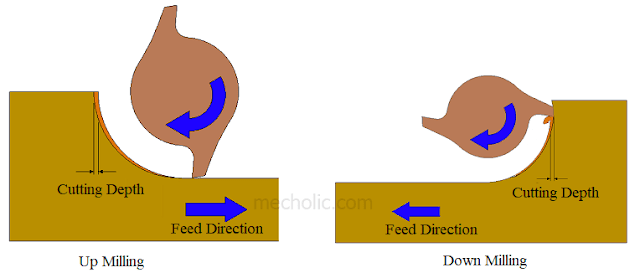Difference between Conventional Milling and Climb Milling
Read: Elements of Plain Milling Cutter - Nomenclature and Angles
What Is Milling and Milling Cutters?
Here is the quick comparison between conventional milling and climb milling.
Conventional Milling
|
Climb milling
|
Also known as up milling.
|
Also known as down milling.
|
Milling cutter rotates against the direction of feed of workpiece.
|
Milling cutter rotates in the same direction of feed of workpiece.
|
Up milling requires higher force.
|
Down milling requires lesser force comparing to up milling.
|
Chip thickness is zero at the entrance of cutting tooth and maximum at
tooth exit.
|
Chip thickness is maximum at the entrance of cutting tooth and minimum
at tooth exit.
|
Cutter has the tendency to pull away from the workpiece from Workbench.
|
Cutter tends to push the workpiece against Workbench.
|
It needs intrinsic work holding device to hold workpiece against
pulling force of cutter.
|
Cutter pushing the workpiece towards the workbench, so there is no need
of special fixture to hold against the force acting by the cutter.
|
Cutting process leaves chips ahead of the cutter. It is carried upward
by the tool.
|
Cutting process leaves chips behind the cutter. It is carried downward
by the tool.
|
Chip disposal is difficult.
|
Chip disposal is easy when compared to Conventional Milling.
|
No tendency to drag workpiece towards the cutter.
|
It tends to drag workpiece into the cutter.
|
Surface finish is poor when compared to climb milling. Generally used
for the rough cutting operation.
|
Good surface finishing, generally used for finishing operation.
|
Tool life is low compared to that of down milling.
|
It possesses longer tool life.
|


